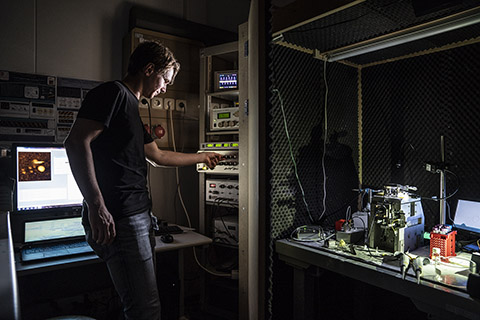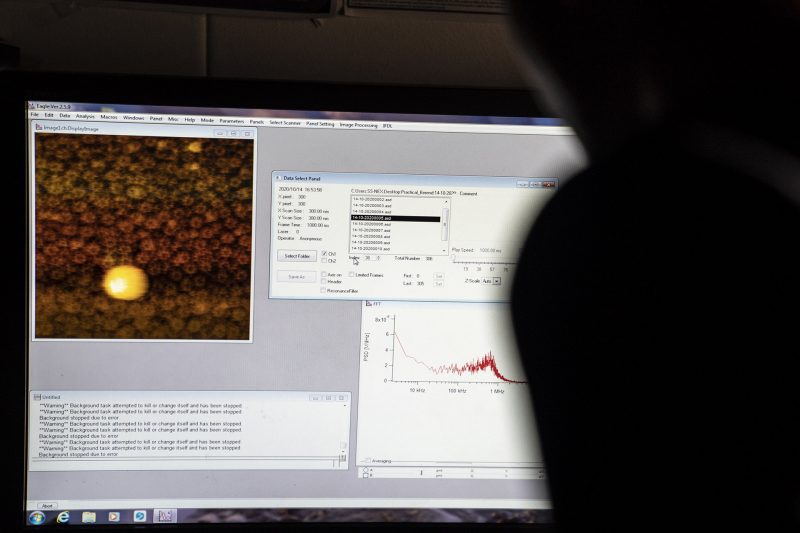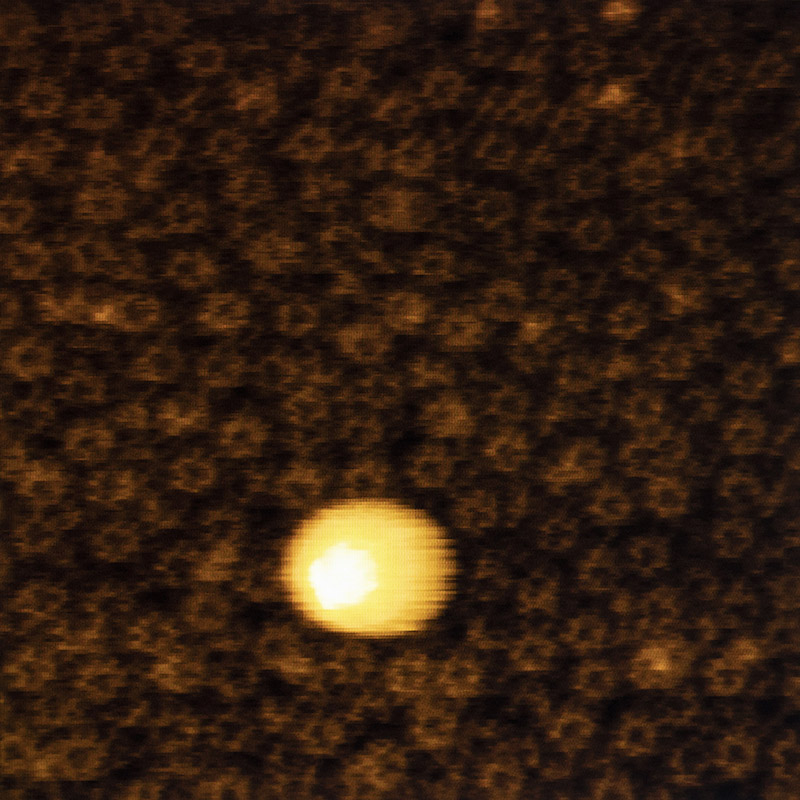
Zooming in to a nanometre
Cracking the virus
With all its wires, electronic bits, and buttons, biophysicist Martijn Middelkamp’s microscope looks very impressive. Not at all like the generic microscope they use in high school biology class. ‘I’m glad I didn’t have to build the whole thing myself’, Middelkamp jokes.
The microscope contains advanced software that enables him to study viruses like the coronavirus down to the smallest detail. Like we said: not your average microscope.
Capsids
Martijn Middelkamp is a PhD in the molecular biophysics group of Wouter Roos at the Zernike Institute for Advanced Materials. The most important part of ‘his’ microscope is also one of the smallest ones: a little tip that is just a few micrometres wide. More than a million times thinner than a human hair. Ideally, the end of the tip would have the width of just a single atom.
Through daily use, Middelkamp has become adept at operating the microscope. The machine is invaluable to his research into the growth behaviour of capsids: a little ball that covers viruses like a jacket. It’s also called a protein shell.
You can insert medication into the capsid to transport it to a specific location in the body
Knowing how this ball grows can be beneficial to creating medications. ‘Let’s say you find a way to block the growth using a particular molecule or medication’, says Middelkamp. ‘You can then use that to develop medication. But you can also insert medication into the virus capsid to transport it to a specific location in the body.’
Wavelength
Studying the growth of capsids isn’t easy, says Middelkamp. A virus is so incredibly tiny that you can’t even see it with a normal light microscope. ‘You can zoom in pretty far with those’, he says, ‘but at some point, you’ll hit the limit.’
That’s because light consists of wavelenghts. If an object is shorter than a wavelength, you can’t see it. Regular light’s minimal wavelength is a few hundred nanometres, which means it’s impossible to see a virus that’s just a few nanometres wide.
No one’s ever used this microscope like that before
That is, unless you have a High Speed Atomic Force Microscope (HS-AFM), which doesn’t use light to look at an object. Instead, it uses touch.
The fragile tip of the microscope moves across the virus’ growing shell, like a needle moving over a constantly growing microscopic mountain range. ‘Every time the tip encounters some of the virus, the arm attached to the tip bends. A laser measures how far it bends, extrapolating the surface height’, says Middelkamp.

Spikes
Thanks to the AFM, he can even see the small protuberances called spikes on a virus. ‘These spikes are just a single nanometre long. We can see things down to an absurd scale.’
Exploring the surface using the AFM has to be done extremely extremely carefully, though. ‘When you’re using the tip to scan a virus, you run the risk of pushing the capsid aside, or whacking it and breaking it’, says Middelkamp. The electronics in the machine ensure that the tip scans as gently as possible.
Interestingly enough, breaking a virus’ shell isn’t always a bad thing. ‘You can also use the microscope to crack open the capsid on purpose. That way, you can study how it falls apart.’ After all, this also leads to valuable information about the virus’ structure.
Middelkamp is currently studying the Hepatitis B virus. He scans the protein’s triangles, pentagons, and hexagons, which together from the virus ball, not unlike the sections of a football. When one piece of protein doesn’t fit right, Middelkamp says, it will detach and ‘look’ for a new place, until the whole protein is stable.
Puzzle

‘It’s not single protein building blocks that do this, but larger conglomerations, like an entire triangle or hexagon all at once.’ Like a jigsaw puzzle solving itself.
‘A virus ball forms in just a few seconds’, Middelkamp explains. ‘In that time, I can record thirty to sixty images of the puzzle process.’ He then puts all these images in order, creating a kind of movie of how a capsid grows. ‘No one’s ever used this microscope like that before.’
Middelkamp studies Hepatitis B because it’s a relatively simple virus, in contrast to, say, Covid-19. It consists of 240 separate puzzle pieces, all made up off the same protein. The Covid-19 capsid consists of at least 2,400 units: ten times as many. The human immunodeficiency virus (HIV) is somewhere in between with a thousand to fifteen hundred pieces, but they consist of two different types of protein.
Simple virus
The principles according to which proteins put themselves together are largely the same, however. As such, it’s smarter if Middelkamp studies a simple virus before moving on to more complex ones. ‘We won’t turn to more complex viruses until we know exactly how the shell of a simple virus is constructed’, he says.
That is his first goal: to get a good overview of all the different puzzle pieces. After that, it will get harder; he’ll be trying to influence the growth process. ‘I’ll be changing the characteristics of the liquid that contains the protein.’
Covid-19 is infinitesimal, but it’s impacted the entire world
If he designs the right circumstance, the proteins will grow into a structure like the capsid. If he doesn’t, nothing will happen. ‘Not all methods are similarly efficient. In some cases, the puzzle steps will take longer.’
Fascinated
The knowledge he’s gaining is essential if he ever wants to develop nanomaterials using capsids. Protein-based nanomaterials are tissue-friendly, which means they can be used in medical science.
But that’s not the most important aspect to Middelkamp. He’s mainly fascinated by the tiny things he’s already working with. ‘I’m constantly amazed that we’re able to see individual molecules, and that we’re able to work with them. I’m amazed by how those molecules affect our daily lives.’ Like the coronavirus, for example: ‘It’s infinitesimal, but it’s impacted the entire world.’